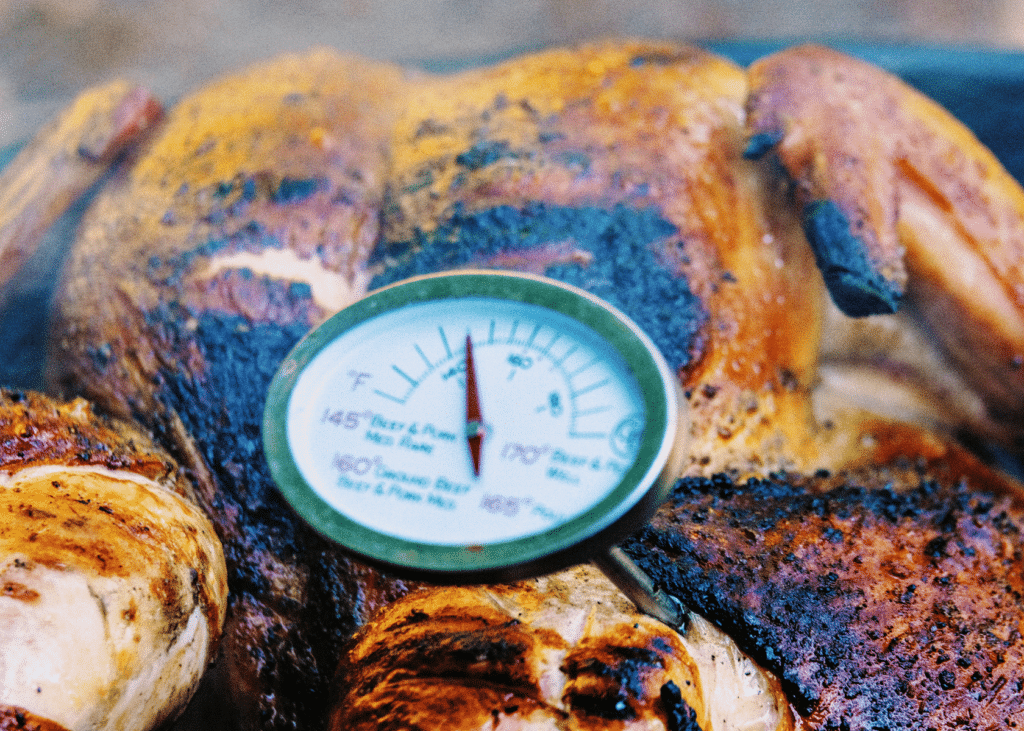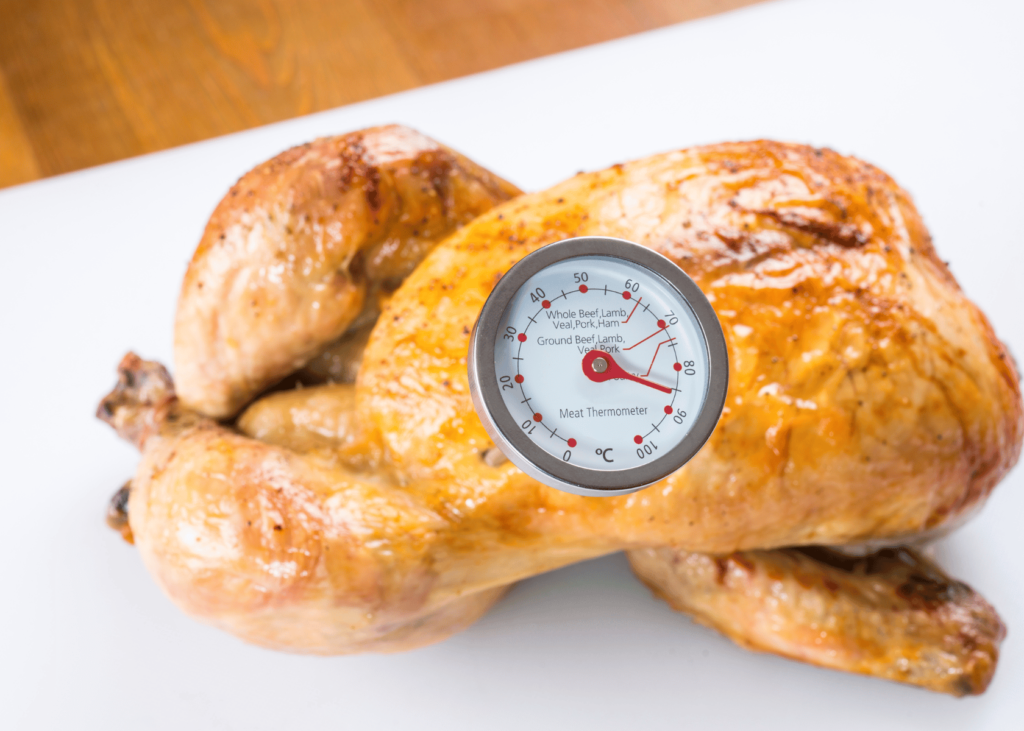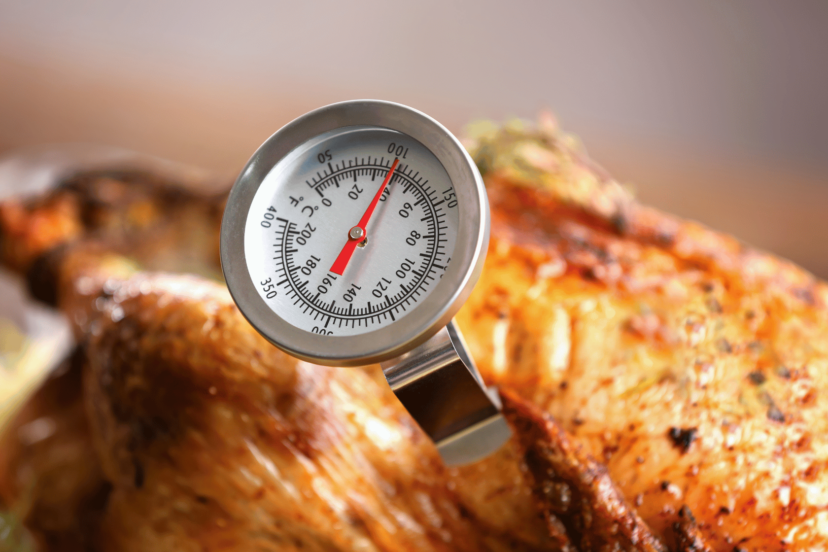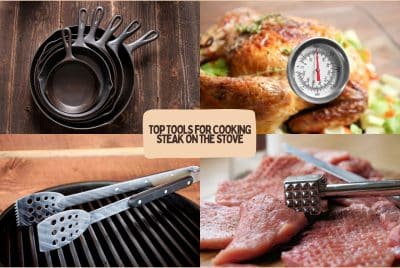Where to Put Meat Thermometer in Chicken?
Are you uncertain about where to put your meat thermometer when cooking chicken? This common culinary conundrum can make the difference between a perfectly cooked bird and food safety risks.
Today, we’ll journey through the necessary steps and secrets of proper thermometer placement for optimal results. Read on if juicy, safely cooked chicken is on your menu!
Table of Contents
- 1 Where to Place the Meat Thermometer in a Whole Chicken
- 2 Importance of Proper Placement for Accurate Temperature Readings
- 3 Recommended Internal Temperature for Cooked Chicken
- 4 Tips for Using a Meat Thermometer in Chicken
- 5 Frequently Asked Questions
- 5.1 1. Where should I insert a meat thermometer in chicken?
- 5.2 2. How deep should I insert the meat thermometer in chicken?
- 5.3 3. What temperature should I look for when using a meat thermometer in chicken?
- 5.4 4. Can I use a different method besides a meat thermometer to check if my chicken is done?
- 6 Conclusion
Key Takeaways
- The meat thermometer should be placed in the thickest part of the thigh and center of the breast when cooking a whole chicken for accurate temperature readings.
- Avoid hitting bone, gristle, or fatty areas when inserting the thermometer to ensure precise readings.
- The recommended internal temperature for cooked chicken is 165°F (74°C) throughout the entire bird.
Where to Place the Meat Thermometer in a Whole Chicken
To ensure accurate temperature readings, it is best to insert the meat thermometer in the thickest part of the thigh and center of the breast when cooking a whole chicken.
Thickest part of the thigh
Positioning the meat thermometer in a chicken is key to achieving an accurate temperature reading. For a whole chicken, your target zone should be the thickest part of the thigh. Guided by this technique, you’re guaranteed that even as different parts of the chicken cook at various rates, the slowest-cooking part, which is also potentially the most hazardous if undercooked, reaches safe temperatures.
Avoid hitting bone or gristle when inserting since these areas can give inaccurate readings. Carefully slide your thermometer into this region, adjusting as needed until it’s midway through and not touching bone for best results.
This placement offers reliable data on whether your poultry has hit that all-important 165°F internal temperature mark for food safety standards. Perfectly cooked chicken with moist and flavorful bites will always be your reward with diligence in thermometer usage.
Center of the breast
For an accurate temperature reading in a whole chicken, it is important to place the meat thermometer in the center of the breast. The thickest part of the breast provides a good indication of how well-cooked the chicken is and ensures that heat has penetrated throughout.
This spot allows you to avoid any bones or gristle that could affect temperature readings. Remember, when using a meat thermometer, make sure to insert it at a slight angle for better accuracy.
By checking multiple areas within the breast for consistent temperatures, you can ensure that your chicken is cooked perfectly and reaches the recommended internal temperature of 165°F (74°C).
Importance of Proper Placement for Accurate Temperature Readings
Proper placement of the meat thermometer in a whole chicken is crucial for obtaining accurate temperature readings. This ensures that the chicken is cooked to the recommended internal temperature and helps avoid undercooked or overcooked poultry.
Avoiding gristle, fat, and bone
To ensure accurate temperature readings when using a meat thermometer in chicken, it’s crucial to avoid hitting gristle, fat, or bone. These elements can give false temperature readings and may not accurately reflect the doneness of the chicken.
Instead, aim to insert the thermometer into the thickest part of the meat without touching any bones or fatty areas. By doing so, you’ll have a more precise understanding of whether your chicken has reached its recommended internal temperature of 165°F (74°C).
Taking this precaution will help you achieve perfectly cooked chicken that is both safe and delicious.
Ensuring even cooking throughout the chicken
To ensure even cooking throughout the chicken, it is crucial to place the meat thermometer in the right spot. This ensures that every part of the chicken reaches the desired internal temperature and eliminates any risk of undercooked or overcooked areas.
By avoiding gristle, fat, and bone when inserting the thermometer, you can get accurate readings from the thickest part of both the thigh and breast. This will help you achieve perfectly cooked chicken that is safe to eat while maintaining its juiciness and flavor.
Remember, consistency is key when using a meat thermometer in poultry to ensure every bite is cooked to perfection.
Recommended Internal Temperature for Cooked Chicken

The recommended internal temperature for cooked chicken is 165°F (74°C) to ensure it is safe and free from harmful bacteria.
USDA guidelines
The USDA (United States Department of Agriculture) provides guidelines for safe cooking temperatures to ensure that chicken is cooked thoroughly and free from harmful bacteria. These guidelines are essential to follow to prevent foodborne illnesses. Here are the recommended internal temperatures for cooked chicken, according to the USDA:
- Whole chicken: The internal temperature should reach 165°F (74°C) throughout the entire bird.
- Chicken breasts: The thickest part of the breast should reach a minimum internal temperature of 165°F (74°C).
- Chicken thighs, legs, and wings: These parts should also reach an internal temperature of 165°F (74°C).
Safety precautions for avoiding undercooked or overcooked chicken
To ensure your chicken is perfectly cooked and safe to eat, it’s important to take certain safety precautions when using a meat thermometer. Undercooked chicken can harbor harmful bacteria, while overcooked chicken can result in dry and tough meat.
To avoid these issues, follow these safety tips.
Firstly, always make sure to clean the meat thermometer before and after each use. This helps prevent cross-contamination and ensures accurate readings. Secondly, insert the temperature probe into the thickest part of the meat without touching bone or hitting gristle or fat.
This will give you an accurate reading of the chicken’s internal temperature.
Additionally, be careful not to leave the thermometer in the chicken for too long once you’ve reached the desired temperature. Doing so may cause overcooking as residual heat continues to rise even after being removed from direct heat.
Always cook your chicken until it reaches an internal temperature of 165°F (74°C), as recommended by USDA guidelines. This high enough temperature ensures that any potential harmful bacteria are killed off while still maintaining juicy and flavorful meat.
Tips for Using a Meat Thermometer in Chicken
Insert the probe at a slight angle to ensure accurate readings throughout the cooking process. Check multiple areas in the chicken for consistent temperatures, avoiding any bones or thick pockets of fat that could affect the accuracy.
Inserting the probe at a slight angle
To ensure accurate temperature readings in chicken, it is important to insert the meat thermometer probe at a slight angle. This helps to penetrate the thickest part of the meat without hitting gristle, fat, or bone.
By inserting the probe at an angle, you can get an accurate reading of the internal temperature and ensure that your chicken is cooked thoroughly. Remember to check multiple areas for consistent readings to avoid undercooked or overcooked sections.
By using this simple technique, you can achieve perfectly cooked chicken every time and enjoy peace of mind knowing it’s safe to eat.
Checking multiple areas for consistent readings
To ensure accurate temperature readings when using a meat thermometer in chicken, it’s important to check multiple areas for consistent results. Insert the probe in different spots throughout the thickest parts of the chicken, such as the thigh and breast, to ensure even cooking and doneness.
This is especially crucial if you’re roasting a whole chicken or larger cuts of poultry. By checking multiple areas, you can confidently determine if the chicken has reached its recommended internal temperature of 165°F (74°C) and avoid any undercooked or overcooked sections.
Remember to insert the thermometer at a slight angle for optimal accuracy and always refer to trusted temperature guidelines for safe cooking practices.
Frequently Asked Questions

1. Where should I insert a meat thermometer in chicken?
To ensure safe cooking, insert the meat thermometer into the thickest part of the chicken’s thigh, without touching the bone. This is because the thigh takes longer to cook than other parts and is a good indicator of overall doneness.
2. How deep should I insert the meat thermometer in chicken?
Insert the meat thermometer about 1-2 inches into the thickest part of the chicken’s thigh or breast for an accurate reading. Make sure that it reaches the center of the meat without touching any bones, as this can affect accuracy.
3. What temperature should I look for when using a meat thermometer in chicken?
For properly cooked chicken, you’ll want to ensure it reaches an internal temperature of 165°F (74°C). This temperature kills any harmful bacteria and ensures that your chicken is fully cooked and safe to eat.
4. Can I use a different method besides a meat thermometer to check if my chicken is done?
While using a meat thermometer is highly recommended for accurate results, there are alternative methods to check if your chicken is cooked through. You can cut into the thickest part of the meat and make sure there are no signs of pinkness or rawness, with clear juices running from it. However, using a reliable instant-read thermometer provides more precise measurements for food safety purposes.
Conclusion
In conclusion, finding the right spot to place your meat thermometer when cooking chicken is crucial for achieving perfectly cooked and safe-to-eat poultry. By inserting the thermometer in the thickest part of the thigh or center of the breast, you can ensure accurate temperature readings and avoid undercooked or overcooked chicken.
Don’t forget to follow USDA guidelines and use a slight angle when inserting the probe for optimal results. With proper placement, you’ll be on your way to enjoying juicy and tender chicken every time!
*We may earn a commission for the purchases made using our links. Please see our disclosure to learn more.




